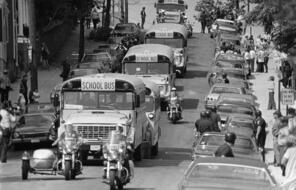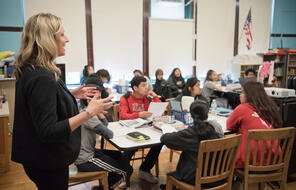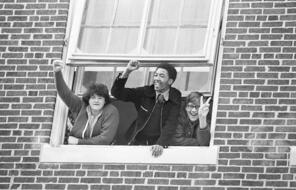Latinx Parents Demand to Be Recognized by the Court
At a Glance
Subject
- Civics & Citizenship
- Social Studies
- Democracy & Civic Engagement
- Human & Civil Rights
- Racism
During the 1974–75 school year, thousands of Boston students were assigned to new schools in order to eliminate segregation. When he ruled in favor of the NAACP in Morgan v. Hennigan, Judge Garrity did not think it was right to delay school desegregation while the difficult process of figuring out which students should attend which schools took place. So he assigned students to schools according to a temporary plan, which he intended to replace the following year with a more carefully designed system.
As Judge Garrity worked on the new school assignment plan for the 1975–76 school year, he accepted proposals from both the plaintiffs (the NAACP, representing Boston’s African American community) and the defendants (the all-white Boston School Committee) in the Morgan v. Hennigan case. As members of Boston’s Latinx community heard about some of the proposals that were being discussed in court, they became concerned and angry.
In court, the judge discussed with the plaintiffs and defendants how Latinx students would fit into a plan to end segregation of white and Black students. One proposal was to classify Latinx children as either “Hispanic-white or “Hispanic-black.” Another proposal simply suggested that Latinx people belong to a category of “Other Minorities.” Latinx activists worried that the court would ignore the way they defined their own identity. “As Puerto Ricans,” organizer Edwin Colina explained, “we saw that as totally contrary to what we are and what our characterization of race is.” Latinx parents and activists insisted that they be classified as “Hispanic.”
Latinx activists were also upset about proposals that were discussed in court that would greatly reduce bilingual education for students who did not speak English. The state required schools to have bilingual classrooms only if there were enough students in that school who spoke the same language (other than English). The court was considering plans that would break up groups of Spanish-speaking and other non-English-speaking students and spread them out in such a way that fewer schools would be required to provide bilingual education.
Believing that Judge Garrity’s new desegregation plan would ignore the identities and the needs of Latinx students, a group of working-class Latina mothers formed El Comité de Padres Pro-Defensa de la Educación Bilingüe (the Parents’ Committee for Defense of Bilingual Education). They petitioned Judge Garrity to become “plaintiff-intervenors” in the desegregation case, which meant that they would be part of the negotiations, alongside the NAACP and the school committee, over the new desegregation plan for the 1975–76 school year. According to historian Tatiana Cruz,
El Comité organized community meetings, fundraised, conducted research on bilingual education and desegregation, distributed newsletters and press releases, wrote affidavits, and developed the plaintiffs-intervenor’s plan. They also staged protests and demonstrations across the city of Boston. “We took ‘em on. We took on the school department, the city, the state, the federal court—a lot of different places,” Edwin Colina reflected. “We had demonstrations in our own community down Dudley Street, or along Tremont Street in the South End, or in front of the school committee, or in front of the Federal Court House. We had Judge Garrity’s courtroom packed many a time. We demonstrated in front of the State House in the snow.” He continued, “We had, on a constant basis, in the early years of the organization, over two hundred fifty people, easy, that would come to a demonstration on a day’s—two days’—notice.” 1
Judge Garrity accepted their petition to become plaintiff-intervenors in the case, giving them input into planning for the next school year. Eventually he accepted nearly all of El Comité’s demands, preserving bilingual education programs in the Boston Public Schools in the 1975–76 school year and for many years after.
- 1Tatiana M. Cruz, ““We Took ’em on”,” Journal of Urban History 43, no. 2 (2017): 235–55, https://doi.org/10.1177/0096144216688278.













